Why guzmania does not bloom: all possible reasons and rules of care
The South American epiphyte guzmania is unexpectedly a popular flower in home floriculture. For growth and budding, this exotic needs room conditions similar to the tropics. There is nothing difficult in this: caring for guzmania consists in creating diffused lighting, watering leaves in a socket, spraying and nutritious dressings.
Plant characteristic
Guzmania, or gusmania, is a visitor to windowsills from South America. The species belongs to the bromeliad family. Flowers grow in tropical rainforests and are epiphytes.
Worth knowing! Contrary to popular belief, epiphytes are not parasitic plants: they grow on tall trees, using only dead bark, foliage, bird droppings and insect remains.
Modern varieties of guzmania at home do not exceed 25 cm in height, and 30 cm in diameter.Leaves of some varieties reach a length of 40 cm.In the wild, leaves can stretch up to 0.7 m.They are not highly decorative, but in some varieties of green plates are covered with contrasting white or pink stripes.
Long glossy leaves form a dense rosette. Guzmania blooms very effectively with a spike-shaped inflorescence growing from the center of this rosette. The flowers themselves are inconspicuous: one bud is formed on one plant, usually yellow, white or orange, less often brown and pink.
The main decorative value of the plant is in the bracts. Their shades range from bright reds and crimson to rich yellows and oranges. There are varieties that combine two colors. Bracts remain fresh and bright for up to six months. Tropicana guzmania will become a worthy decoration of any room, but care and attention will be required from a florist.
An interesting fact: the pineapple is a relative of the flower, and against the background of this relative, the guzmania is unpretentiousness itself. Pineapples at home take root reluctantly.
What kind of care does Guzmania like?
Caring for guzmania at home must be adjusted to the usual climate of the plant - tropical. It is also necessary to take into account that the flower is an epiphyte and grows in forests.
Accommodation rules
Guzmania will feel comfortable on the windowsill if the window is slightly shaded. The plant suffers greatly from direct sunlight. In the wild, the flower is based on trees and grows in diffused light. But it is undesirable to put it in the shadow. The more diffused light the guzmania receives, the brighter its bracts and buds will be. The optimal side for placing a flowerpot is east or west.
In autumn and winter, window shading can be removed. Daylight hours for a flower should last at least 8 hours. In addition, those plants that stand far from natural light sources are illuminated with lamps.
Comfortable temperatures for an indoor flower in summer are from +18 to +24 degrees, in winter - from +16 to +18. If the room is warmer, the flower will need additional moisture.
The room where the guzmania is located should not be exposed to drafts. Cold air currents negatively affect the flowering of exotic plants.
Another condition for flower placement is high humidity. The higher it is, the better the Tropicana feels. Guzmanias are often grown in the kitchen, where moisture evaporates from cooking and washing dishes.
How to water
Watering is carried out in an unusual, at first glance, way: the stream is directed directly into the leaf outlet. Thus, the tropical plant has adapted to the limited space.You need to fill the outlet by 2-3 cm. Water should be taken soft and warm, temperature - 3 degrees above room temperature.
After 10 minutes, the water must be drained. Some growers leave some water in the outlet, replacing it with fresh water once a week. The accumulation of moisture can provoke diseases, therefore, at the first signs of decay, this method of watering must be abandoned.
The frequency of watering in spring and summer is once every two days. In autumn and winter, moisture input is reduced to once a week.
The soil in the pot is watered as it dries. In the hot season, the procedure is carried out once a week, after a cold snap every two weeks. Moss, pebbles and expanded clay are placed in pallets to retain moisture in summer.
The flower needs spraying. They are held in the morning and evening every day. Water is simply sprayed around the bush with a spray bottle. Once every 10 days, you can additionally wipe the leaves with a damp sponge. And it is better to refuse waxing the sheet plates for shine.
In winter, you should beware of waterlogging the flower. If the temperature drops below +16, it is better to drain the remaining water from the outlet immediately. Excess moisture at low temperatures easily causes leaf rot. Watering in winter is rarely carried out, but you should not give up spraying, especially when the gusmania pot is adjacent to heating devices.
Advice! Watering with chlorinated water is harmful to gusmania. You need to filter tap water or use bottled water.
Top dressing
Monthly fertilization will only improve the appearance of your indoor flower. Guzmania responds well to liquid complex preparations for bromeliads. Fertilizer, dissolved in water, is poured over a rosette of leaves and the whole plant is sprayed. The period of top dressing is from May to August.
If there is no fertilizer for bromeliads, conventional complexes for flowering plants will do. The composition of the preparations should not be dominated by nitrogen. The dosage of such fertilizers is reduced by 4 times so that the guzmania does not suffer.
Transplant rules
Purchased gusmania is not recommended to be moved to a new pot immediately after moving from a store to an apartment. The plant must adapt to new conditions. If the old pot is too small, it is best to wait about two weeks and then change the container. Transplants are scheduled for spring and carried out annually.
Each new container should slightly exceed the parameters of the previous one. Suitable pots are wide and low. Small capacity promotes rapid flowering.
Not all types of soil are suitable for epiphytes. Substrate, which is prepared for growing at home: 2 parts of sod land and 1 part each of sand, humus and peat. To increase the nutritional value and looseness, a little sphagnum moss, crushed charcoal and parts of coniferous trees - needles and bark are introduced into the soil. It is a good idea to buy a special soil for bromeliads, orchids or epiphytic plants.
Guzmania transplant stages:
- The bottom of the container is filled by 1/3 with a drainage layer of pebbles and expanded clay. Such a pillow is necessary so that the root system does not rot from excess moisture in the pot.
- A little soil mixture is placed on the drainage layer.
- Guzmania is moved out of the old pot carefully, along with a lump of earth, taking care not to damage the fragile roots.
- The container is filled to the top with the remaining soil. It is better not to compact the substrate.
- The transplanted flower is watered abundantly.
Why guzmania does not bloom: reasons and solutions
Not all growers know that guzmania begins to bloom from the 4th year of life. A young plant does not need to be disturbed: it must grow enough to form flowers. Another feature is that the plant blooms once in a lifetime. When the bracts wither, the plant gives off layers and dies. Further cultivation switches to these shoots: when they reach 14 cm in height, they are separated with a sharp knife and transplanted into separate containers.
Why guzmania does not bloom, possible causes and solutions to the problem:
- The most common reason for the lack of budding - dry air in apartments. Florists neglect the spraying procedure, place the pots close to the batteries. Solution: often spray the air around the plant with a spray bottle.
- An equally popular reason for the lack of flowers - Gusmania disease. Rot in the outlet or on the roots is caused by waterlogging. Solution: in case of severe damage - immediately transplant the flower, with a moderate degree of ailment - pour out the water from the outlet, reduce moisture.
- Indoor drafts delay flowering. Solution: rearrange the guzmania in more stable conditions.
- If the plant constantly gets direct sunlight, it makes no sense to wait for flowering. Solution: plant the plant in light partial shade.
- Low temperature indoors, too, does not allow the peduncle to form. Comfortable conditions for guzmania are warm and humid. Solution: rearrange it to a warmer room or turn on the heater (in the latter case, it is important to regularly spray the guzmania so that it does not dry out).
- The pot is too spacious - a negative factor, and there will be no budding until the flower grows. Solution: wait or transplant into a smaller container.
- Finally, lack of food also will not allow gusmania to bloom. Solution: Fertilize at least once a month.
Advice! In order not to shorten the flowering period of the guzmania, after the appearance of the peduncle, spraying should be minimized, and during the procedure, try not to get on the bracts.
To persuade a plant to release a flower bud, experienced gardeners use a folk trick with an apple or other fruit (banana, pear).
The fruit is placed in a flower pot under a plastic bag. The fruit releases acetylene and other substances necessary for flowering, and if it starts to rot, it is replaced with fresh. Guzmania in a bag with an apple can be kept for up to three weeks. When the flower arrow looks out, all the devices are removed. The only limitation is that the method cannot be used if the plant is younger than 1.5 years.
Other growing problems
The plant must be healthy in order to put on a full flower stalk and please the owner with tropical beauty.
What mistakes do flower growers make in caring for guzmania:
- roots rot - poor drainage or overflow;
- brown spots on the leaves - sunburn;
- the tips of the leaves turned brown - dry air or lack of water in the outlet;
- foliage darkened - hard water;
- the leaves are limp and wilted - the room temperature is too low;
- leaves curl - parasitic insects;
- gray and brown spots on the stem and leaves - fungus;
- lack of children - nutritional deficiency.
Decorative guzmania is known not only for its beauty and unusual flowering. The plant purifies the air in the house, suitable for decorating offices. There are beliefs that the flower symbolizes masculine strength and longevity, has a positive effect on sleep patterns, and helps to cope with depression. Growers celebrate the flowering of creativity when the guzmania settles in the house.

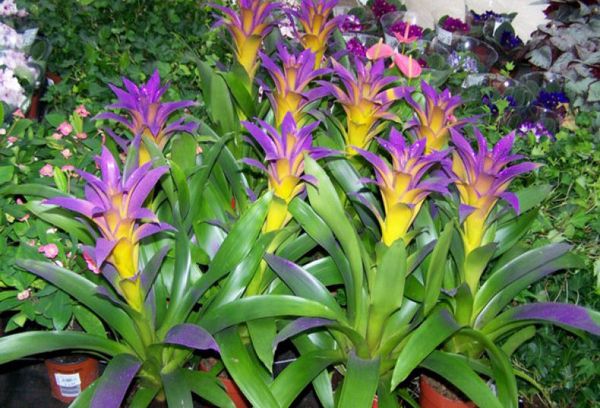
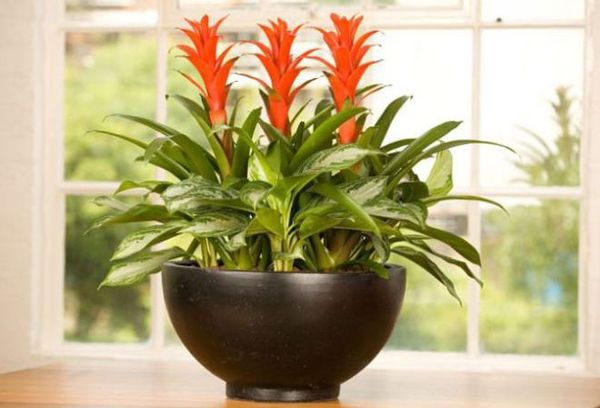
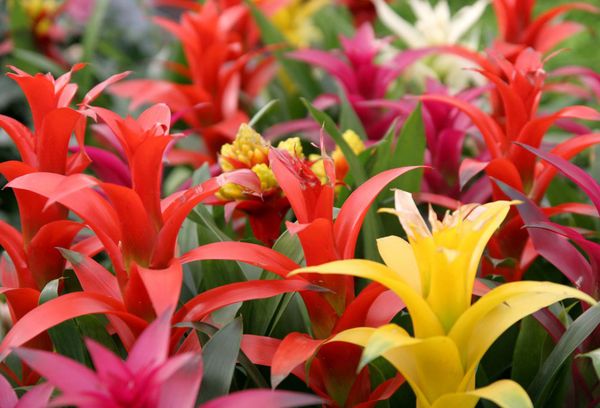

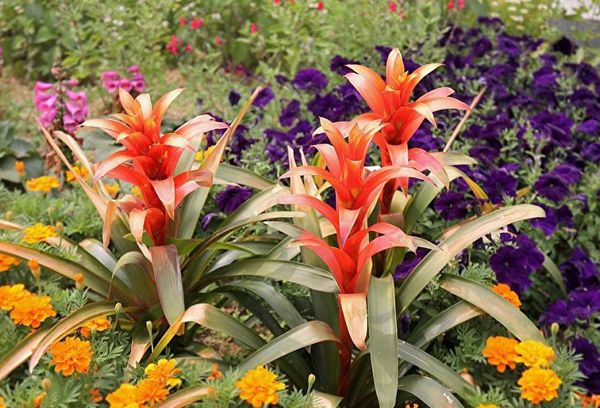
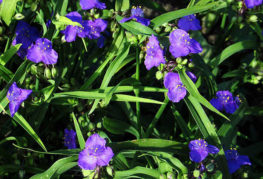
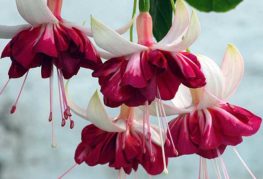
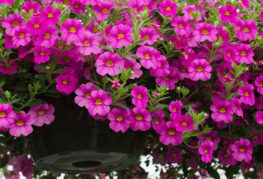
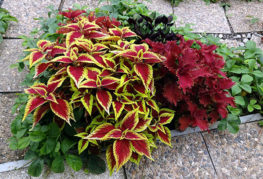


and will be published shortly.